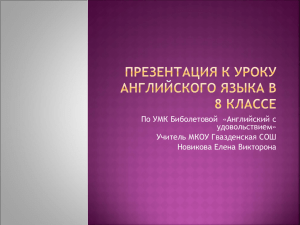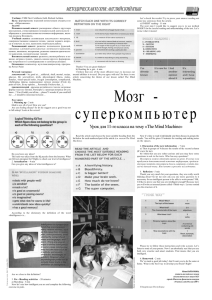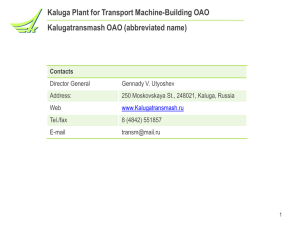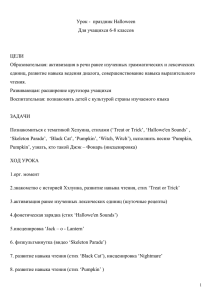юнисеф - Unicef
реклама
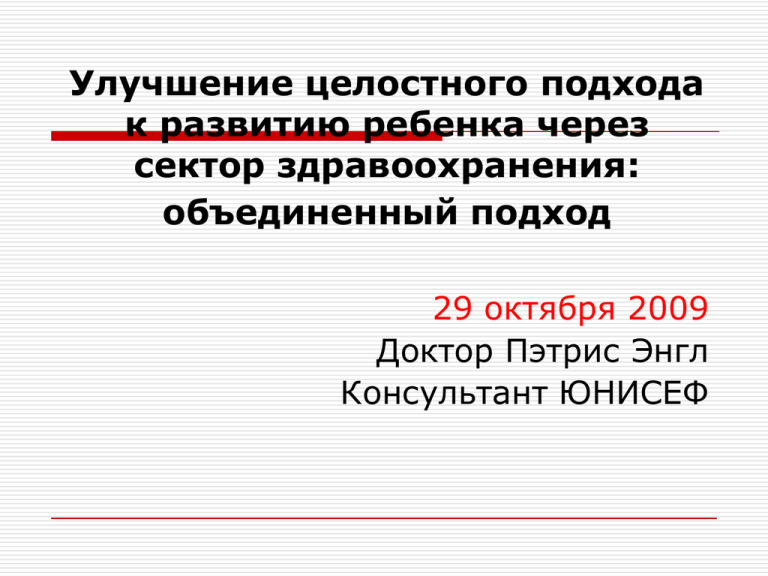
Улучшение целостного подхода к развитию ребенка через сектор здравоохранения: объединенный подход 29 октября 2009 Доктор Пэтрис Энгл Консультант ЮНИСЕФ Что такое развитие ребенка? Постепенное появление способности думать, речевых навыков, навыков общения, рост и точность движений, ощущения и восприятия, социальное и эмоциональное развитие – происходит в виде взаимосвязи опыта и биологического развития Быстрее всего ребенок развивается в течение первых трех лет жизни В этот период он наиболее подвержен биологическому и социальному риску Для чего нужно инвестировать средства в РДРВ? Права ребенка – особенно права социально изолированных детей 200 миллионов детей по всему миру не развивают свой потенциал полностью Вмешательство в этом возрасте, скорее всего, будет эффективнее вмешательства в более старшем возрасте Раннее вмешательство потребует гораздо меньше затрат и принесет больше пользы Преимущества инвестиций в развитие в раннем детском возрасте Совокупные государственные инвестиции Норма окупаемости = 1 Дошкольн ый 0 Школьный Старше школьного Оптимальный уровень инвестиций Воз раст Source: Heckman & Carneiro Human Social Policy, 2003, Voices for America and the Child and Family Policy Center. Early Learning Left out An Examination of Public Investment in Education and Development by Child Age, 2004 Что говорит наука о развитии мозга? • Синаптические связи мозга развиваются в первые два года В зависимости от соответствующего питания Запрограммированы на опыт Могут быть подвержены негативному воздействию токсического стресса Опыт влияет на различные аспекты развития мозга на разных этапах жизни Слух и зрение: первые 3-4 месяца Понимание речи: 6 мес. - 2 года Мышление и решение проблем – 7 мес. – 10 лет Что влияет на развитие ребенка? Анализ факторов риска. Серия Ланцет 2007 Риски для недостаточного развития Плохое питание Хроническое недоедание, приводящее к низкорослости Йодо-дефицит Железо-дефицит Отсутствие грудного вскармливания Отсутствие стимулирования – отзывчивое взаимодействие с лицом, осуществляющим уход Estimated cumulative words addressed to child Важность опыта на раннем этапе: приблизительные совокупные различия в речевых навыках к 4 годам оказывают влияние на восприятие прочитанного 50 млн Высокий доход 40 млн средний 30 млн Низкий 20 млн 10 млн 0 0 24 3 1 6 2 Возраст ребенка, мес 48 1200 Количество слов в лексиконе ребенка Профессион альный Количество слов 1000 800 Средний класс 600 400 Социальная помощь 200 0 10 12 14 16 18 20 22 24 26 28 30 32 34 36 Возраст ребенка, мес % знающих, по крайней мере 50 слов Реакция/отзывчивость на овладение ребенком языком влияет на развитие речевых навыков 120 100 Дети, чьи матери очень отзывчивы 80 60 40 Дети, чьи матери не отзывчивы 20 0 13 UNICEF 15 17 19 21 Месяцы Tamis-LeMonda et al 2001 Детям необходимо стимулирование – а не это! Вот так! или так Необходимы вмешательства, комбинирующие здоровье, питание и развитие ребенка Данные показывают, что и питание и стимулирование имеют положительный эффект на развитие ребенка Без программ, направленных как на развитие, так и на питание ребенка мы упускаем важную возможность Благоприятная окружающая среда улучшает синаптогенез в гиппокампе и коре головного мозга Контрольная Улучшенная среда Светлый столбец: контроль., темный: улучшенная среда synaptophysin Levi O, et al. Neurobiol Dis. 2003 Aug;13(3):273-82. Преимущества комбинирования программ Плохое когнитивное развитие и питание ведут к низкой успеваемости в школе и производительности в зрелом возрасте Качество взаимоотношения ребенка и лица, оказывающего уход является критическим для роста и развития ребенка Качество ухода зависит от статуса питания и психического здоровья ухаживающего лица (матери) Роль сектора здравоохранения Reaches children in the critical earliest years Health is a state of well-being Intergenerational transfer – educated mothers have children who survive more. New Mandate by WHO Commission on Social Determinants of Health 2008 WHO concludes: “Experiences in early childhood and in early and later education, lay critical foundations for the entire life course” “A more comprehensive approach to early life is needed, building on existing child survival programmes and extending interventions in early life to include social/ emotional and language/cognitive development.” Intervention in Jamaica: both stimulation and food help stunted children develop cognitive skills 110 IQ non-stunted Both stim and suppl. stimulated 105 100 supplemented 95 control 90 85 Baseline 6 mo 12 mo 18 mo 24 mo Grantham-McGregor et al, 1991 Эффекты от программ саплементации и стимулирования развития на детей, страдающих низкорослостью на Ямайке 110 IQ Нормальный рост Обе программы Подвергались стимулированию Саплементация 105 100 95 Контрольная 90 85 Исходные данные 6 мес 12 мес 18 мес 24 мес Grantham-McGregor et al, 1991 Effects of combined improved nutrition and environment 115 111 110 105 105 101 105 100 <24 mos >24 mos IQ 100 95 94 90 85 Severely malnourished Moderately malnourished Well nourished Adapted from Winick et al 1975, 1977 IQ scores among female Korean orphans vary by history of malnutrition a age of adoption, favoring better nutrition and younger age of adoption. Nurse-Family Partnership Program (Olds) 25 Program Goals Key Program Components Why Nurses? • Improve pregnancy outcomes • Improve child health and development • Improve parents’ economic selfsufficiency • First-time, at-risk mothers • Registered nurses • Intensive services (intensity, duration) • Focus on behavior • Program fidelity • Knowledge, judgment and skills • High level of trust, low stigma • Credibility and perceived authority • Nursing theory and practice at core of original model Research 26 Monetary Benefits to Society 27 What can we conclude? Strong links between quality of the environment and both growth and development Health sector should aim to improve both growth and development Preventative as well as therapeutic interventions are needed Models to put into practice through Health Sector: An example Care for Child Development Module of IMCI Introduced in Kyrgyzstan from 2004 Intervention models Age up to 6 months: Talk to your child and get a conversation going with sounds or gestures UNICEF/WHO Care for Child Development Module Mother’s Card with care for development messages Recommendations for Feeding During Sickness and Health and for Care for Development Up to 4 Months of Age 4 Months up to 6 Months 6 Months up to 12 Months Breastfeed as often as the child wants, day and night, at least 8 times in 24 hours. Breastfeed as often as the child wants, day and night, at least 8 times in 24 hours. Breastfeed when the child shows signs of hunger: beginning to fuss, sucking fingers, or moving the lips. Only if the child: - shows interest in semisolid foods, or - appears hungry after breastfeeding, or - is not gaining weight adequately, Add complementary foods (listed under 6 months up to 12 months). Do not give other foods or fluids. Give these foods 1 or 2 times per day after breastfeeding. Continue to feed when the child shows signs of hunger; do not wait for the child to cry. Play: Provide ways for the child to see, hear, feel, and move. Communicate: Look into your child's eyes and smile at him or her. When you are breastfeeding is a good time. Play: Have large colourful things for your child to reach for, and new things to see. Communicate: Talk to and respond to your child. Get a conversation going with sounds or gestures. 12 Months up to 2 Years 2 Years and Older Breastfeed as often as the child wants. Breastfeed as often as the child wants. Give adequate servings of: Porridge with added oil, peanut butter or ground peanuts, margarine, mashed banana, and chicken, beans, full cream milk, fruit and vegetables, spinach, mashed avocado or family food. The child should eat at least 3 times per day. (If not breastfed, should eat at least 5 times daily.) Give finger foods in small chewable pieces. Let the child try to feed self, but provide active help. Give adequate servings of: Porridge with added oil, peanut butter or ground peanuts, margarine, chicken, beans, full cream milk, fruit and vegetables, mashed avocado or banana, canned fish or family food. Give family foods at 3 meals each day. Also, twice daily, give nutritious food between meals, such as bread with peanut butter or marmite, fresh fruit or full cream milk. The child should eat at least 5 times per day. Offer a variety of foods. If a new food is refused, offer “tastes” several times. Show that you like the food. Play: Actively play with your child. Give your child clean, safe household things to handle, bang and drop. Communicate: Respond to your child’s sounds and interests. Tell the child the names of things and people. Continue to actively help the child to eat. Play: Give your child things to stack up, and to put into containers and take out. Communicate: Ask your child simple questions. Respond to your child’s attempts to talk. Play games like “byebye” and “peek-a-boo”. Feeding Recommendations for a Child Who Has PERSISTENT DIARRHOEA If still breastfeeding, give more frequent, longer breastfeeds, day and night. If taking other milk: - replace with increased breastfeeding OR - replace with fermented milk products, such as amasi (maas) or yoghurt OR - replace half the milk with nutrient-rich semisolid food. For other foods, follow feeding recommendations for the child’s age. Play: Help your child count, name, and compare things. Make simple toys for your child. Communicate: Encourage your child to talk. Answer your child’s questions. Teach your child stories, songs and games. Evaluation of Care for Development in Turkey: % of Intervention and Control families reporting (N= 194) CG reads to child Homemade toys HOME>38 Others new play Parents do new play activity 0 20 40 60 80 Ertem et al, 2006 Intervention Control 100 Care for Development in rural China (Jin et al., 2007) Randomized Control Trial of Care for Development 50 intervention and 50 control Children<24 months Measured effects on child development and parent attitudes Intervention: 2 sessions in home over a 6 month period delivered by a counselor Shanghai Children’s Medical Center Inst. For Med Research, Melbourne, Australia Characteristics of the intervention Used IMCI counseling: Ask and Listen, Praise, Give Advice, Check Understanding Used problem list and did problem-solving with caregiver to be sure that she could do activities – e.g., time, materials Used practice and demonstration Gave Counseling Card to mother 30-60 minutes per session Results of the trial No baseline differences (age = 10 mos) Average intervention child increased by 8.7 Development Quotient points 96% of Intervention mothers understood recommendations vs 2% control 91% Intervention mothers found recommendations “easy to implement vs. 67% control Changes in DQ units from pretest to posttest * 10 * 8 * 6 4 2 0 -2 Motor Adaptive Intervention Lang Social Control Jin et al. (2007) * p<.05 Review of IMCI/ECD in Kyrgyzstan New version of Care for Child Development launched in July To discover how effective your implementation was To inform other countries as they roll out new version To improve Care for Development in Central Asia – 3 countries Health Sector strategies for ECD in the region Kazakhstan: IMCI; Policy on Healthy Baby Rooms; combine with GMP, immunization Tajikistan: IMCI; Community Health Promoters run group sessions (12 topics) ECD One of top 3 topics (HIV, water and sanitation, and ECD - 924 in 6 mo TV programs; advocate for limited bishek Turkmenistan: ECD/IMCI plus developmental monitoring in 10 districts; Airline funds H, N, and ECD information Working on comprehensive National Plan of Action for health, nutrition and ECD Gulazak and ECD – a good match Kyrgyzstan is the first to link home iron fortification and ECD messages Information for medical workers Information for parents Give family a book for child when they pick up their sprinkles WHY put together? Iron supplementation increases activity and exploration – and child development Mexico – iron deficiency associated with reduced activity and exploration 4-12 mos (Aburto et al., 2009) Bangladesh – 6 months supplement with iron and zinc led to increased: Engagement with learning Exploration Arousal and positive emotion Fearlessness (Black et al., 2004) Indonesia – iron and energy supplement reduced time child spent being carried (Walka et al., 2000) An example of linking iron and ECD: Dr.M. Zeitlin, Senegal 1. The Positive Deviance approach to parent education Positive Deviance (PD) investigation 2 week workshop for mothers and children 2. Previously identified problems and PD solutions: Anemia, malnutrition and learning School readiness TO COMBAT ANEMIA: Mothers cooked nutritious traditional recipes together and fed them to their anemic children. Supplemental iron and deworming speeded the children’s recovery ANEMIA ILLUSTRATIONS FROM THE WORKSHOPS Lack of oxygen to the brain prevents anemic children from concentrating on their environment (before rehabilitation) Non-anemic children concentrate and learn actively (after rehabilitation) BEFORE IRON SYRUP OR TABLETS children with hb ~ 9 gm/dl were passive and apathetic RECOVERING CHILDREN AT END OF PROGRAM danced and raced around the school compound (Yoff – Dakar) An Holistic Approach to ECD is the Best Comprehensive health services – preventative and promotive and incorporating principles of child development LEARNING Early Learning Early care and education opportunities in nurturing environments where children can learn what they need to succeed in school and life HEALTH, Family Support Mental Health and Nutrition Early identification, assessment and appropriate services for children with special health care needs, disabilities, or developmental delays Special Needs/ Early Intervention Economic and parenting supports to ensure children have nurturing and stable relationships with caring adults The question is: What can Kyrgyzstan gain by linking nutrition and health interventions with child development? What can children gain? Can we afford the loss?

